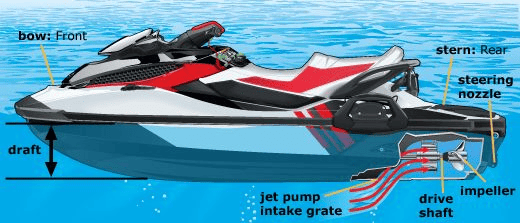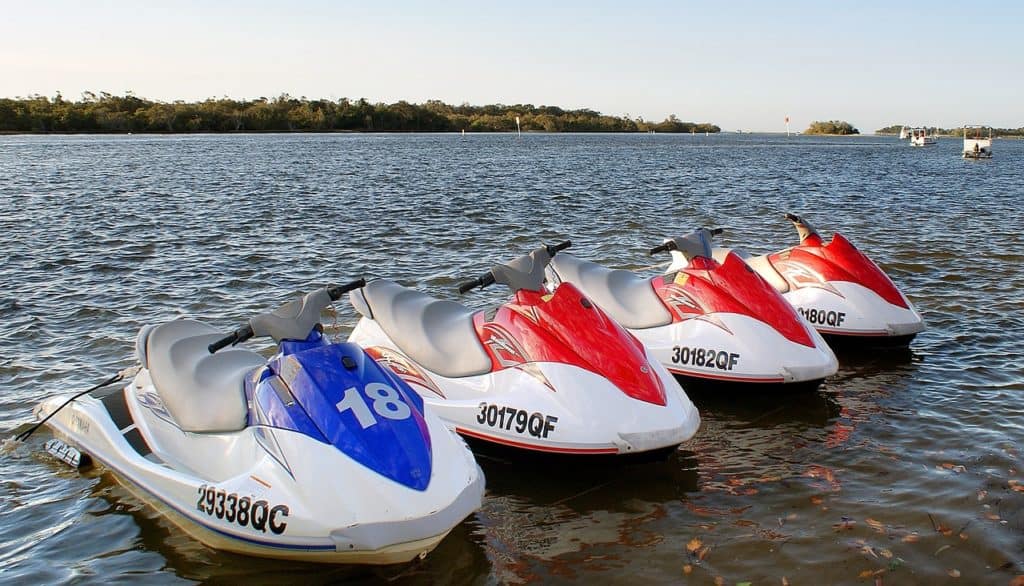How Do Jet Skis Work?

Jet skis are one of the most popular watercrafts of our time, and with good reason. But, one thing most people don’t know about water jet skis is how they actually work.
Knowing how a jet ski works is part and parcel of learning how to ride a jet ski. With a deeper knowledge of how jet skis work, and how the components all work together to give you propulsion, you will most definitely be able to ride better.
It’s like a regular car. If you don’t understand that the accelerator pedal feeds gasoline into the engine, you’re able to understand what it takes to control a car – gas. Plus, understanding how the spark plug ignites the gasoline to make power means when your car stops working, you have knowledge about at least one thing that could go wrong.
We’ve put together this quick and easy-to-understand guide about how jet skis work because, as the best jet ski instructors in the New York City area, we believe understanding your machine is key to understanding how to have a thrilling and – perhaps most importantly – safe ride. See you on the waves!
How A Jet Ski Works
Jet skis are pretty simple machines.

The basic premise is that, whereas a car’s wheels pull on the ground beneath them to move forward, the jet propulsion engine – one of the most important jet ski parts – in a personal watercraft does a similar thing.
Jet ski engines pull in water, and push it out the back end. The water being pulled in moves the jet ski forward just slightly, but it’s the power built into the engine as it pushes it out that moves you forward. As the water caught in the engine collides with the water of your surroundings, you begin to move.
You can think of it like swimming. As you paddle your hands and feet through the water, you are changing your position by pushing water back behind you. Just like in a car, or rock climbing, movement is a consistent pulling and pushing of the medium in which you are traveling.
How Does Water Get Into a Jet Ski Engine?
Water gets into a jet ski engine with an impeller.
An impeller is a motorized fan that pulls water into the craft. It is situated differently than a regular fan, which is designed just to push air away from it – the impeller in a jet ski keeps a constant stream of water entering the craft, for the jet propellor to push it out.
Once water is within the watercraft, the jet propulsion system shoots it back out. As above, its this propelled water smashing with the surrounding water around you that moves you forward.
Just to put it more simply – if you filled a jet ski with water, then lifted it out of the water, it wouldn’t go anywhere because air is significantly less dense than water. The water being pushed out the back would just fall down to Earth, giving you no forward motion whatsoever.
Watercraft Engine and Motor
Motors for standard jet skis have a power of around 150 horsepower, which actually does mean “the power that can be produced by 150 horses.” It’s an old way of measuring power in engines and motors, but it seems to have stuck. When someone asks, “how much horsepower does a jet ski have”, you’ll know that the answer is approximately 150!
Some people will choose to install motorcycle engines in a jet ski, as they have similar power ratings and, in some cases, fit right in. Modifying jet skis is only something that should be done with a licensed service professional, unless you have extensive experience. An improperly-installed jet ski motor or engine poses a major danger to its riders, so don’t skimp on those installation costs if you are able to cover them.
In most cases, you can top out at speeds of about 40 MPH, but there are many which are much faster. Higher speeds come from having higher-powered motors, or those with a higher horsepower rating.
Is a Jet Ski Safe?
Yes, Absolutely!

Jet skis are vehicles made to stay afloat in water, so it’s exceedingly hard to flip a watercraft while riding it. But, as with everything that is exciting, there is obviously risk involved.
If you’re thinking of learning how to ride a jet ski, you should consider proper training. At Sea the City, we take the most inexperienced riders and get them up in running in minutes. With the right guide to walk you through the fundamentals of jet skiing and personal watercraft control, even your grandmother could ride a jet ski.
How Does a Jet Ski Work? The Science Behind It All
Now that you could answer the question ‘how does a jet ski engine work,’ let’s go way back in history to discover how they came to be! Believe it or not, if it wasn’t for Sir Isaac Newton, jet skis wouldn’t exist. You see, that’s because Newton figured out his third law, ‘action and reaction,’ which helps explain how the process works.
So, what does Newton’s third law of action have to do with anything? Well, let’s first take a look at what the law actually says: “For every action, this is always an equal and opposite reaction.” Essentially, this means that going forward requires a backward motion. For instance, when you’re swimming freestyle, you have to pull your arms backward to propel your body in a forward direction. This principle is also used when you’re skateboarding, where you have to kick backward to move forward. Additionally, airplane jet engines and space rocket engines must experience a backward force of hot gas to be hurled forward through the air.
How is a PWC Propelled Through the Water?
When it comes to Newton’s third law, there are a lot of people who are very confused. After all, why don’t the two forces—action and reaction—simply cancel each other out? After all, if you have a backward and forward motion, shouldn’t that simply make you go nowhere? Well, the answer comes down to the action and reaction acting on very different things.
Let’s use the swimming example again. The action that pulls you backward is actually done to the water itself. Meanwhile, the reaction causes your body to move forward. Because the action and reaction are done to two separate things, it’s impossible for them to cancel each other out.
What does all of this have to do with riding a jet ski? Simple! Action and reaction explain the very process through which a jet ski works. First, you’ve got a small pump, which contains a rotating component known as an impeller. Then, once you crank the throttle, the pump pulls water in, which is then blasted back out a hole at the back of the jet ski.
In other words, the action is the force of the jet pushing backward, and the reaction is that the jet ski moves forward!
Why Do Jet Skis Need Such a Powerful Engine?
If every action has an equal and opposite reaction, then why is it necessary for a jet ski to have such a powerful engine? We can chalk it up to a law of physics known as conservation of momentum. This particular law states that the momentum (mass x velocity) of a personal watercraft (PWC) must equal the watercraft’s momentum (along with its passengers) as it moves forward.
To make this particular law work, it’s necessary for a jet ski to crank out a lot of power. That’s due to the fact that the water itself weighs much less than the jet ski. Therefore, the water must achieve an immense speed in order to push the PWC forward.
Who Invented PWCs?
Because PWCs require such an immense amount of energy, it took until the 1960s for someone to invent them. One man, Clayton J. Jacobson, is the credited inventor. Of course, he had to rely on several other people to make the components, including the propeller and fiberglass hull. Still, when it comes to putting them all together into a PWC, Jacobson gets the credit.
As with most inventions, however, it’s not nearly so cut and dry. Theodore Drake patented his Aquatic Device in 1942, and it strongly resembles a modern-day jet ski. Plus, Julius Hamori was granted a patent for his Water Ski Shooter in 1968. In fact, it wasn’t until 1969 that Jacobson’s Power-driven aquatic vehicle gained a patent.
What was the difference between these inventions? All three of them contained the basic building blocks for today’s jet skis. However, Jacobson’s patent was the only one that contained every key feature you’ll find in a modern jet ski. Therefore, as the saying goes, “history is written by the victors.” Or, to put it another way, Jacobson’s patent came the closest, it won, and the rest is history.
Modern-Day Jet Skis
It’s kind of hard to believe that jet skis trace their lineage back to Sir Isaac Newton, but it’s the truth! Now, they’re one of the most maneuverable and fastest boats on the sea. Marines and lifeguards don’t use them without a good reason, after all.
When you decide to rent one of these massively powerful machines, you can say thank you to Newton, the third law of action, and the law of physics’ conservation of momentum. That’s a lot of hardcore science for such a fun PWC. Jet skis are truly amazing—and they’re amazing to ride, too!
Can you imagine yourself out on the water cutting across the waves with sunlight drenching your body? This is one of the most freeing experiences that a person can have. It’s unlikely that you’re going to spend any time reflecting on the science behind jet skiing as you’re hit by sea spray, but it’s still a good thing to be aware of.
Which Jet Skis Are Available at Sea the City?

Sea the City has been investing in jet skis since 2015, and we now have 18 Yamaha EX Waverunners. Each one of these PWCs can achieve speeds of up to 50 MPH. This speed may feel fast in a car, but it feels extremely fast when you’re on the water. We offer guided jet ski tours, but you’ll be fully in control of your own vehicle. Even if you’ve never ridden a jet ski before, we’ll give you the necessary information to be able to have a fantastic time!
Keep in mind that every driver will need to be at least 18 years old. If you have someone who is younger with you, they’ll be able to ride on a single jet ski with you, as long as they’re at least 12 years old.
Are You Ready to Try it Out?
If you think you’d like to try out jet skiing, contact us today. As New York City’s premier jet ski tour guide and training destination, you can experience the beauty of the city from one of the best places – from the water.
Book your jet ski tour today.

Frequently Asked Questions
- How does a jet ski operate?
Jet skis operate using a jet drive system, where an inboard engine powers a water pump that sucks water in and expels it at high speed through a nozzle, propelling the jet ski forward. - Why do jet skis shoot water in the air?
Jet skis shoot water in the air as a byproduct of their propulsion system; the water expelled through the jet nozzle creates a visible spray as it exits at high speed, aiding in steering and stability. - How does water get to the engine in a jet ski?
In a jet ski, water is drawn into the engine through an intake grate located at the bottom of the hull; this water is then used by the jet pump for propulsion and sometimes for engine cooling. - Do jet skis flip over easy?
Jet skis are generally stable and designed to stay upright, but they can flip over if driven recklessly or in rough conditions, although they can often be righted again by the rider. Sometimes, no matter what you do, you fall off your jet ski. Unfortunately, attempting to reboard from the side will cause the water vehicle to flip. Luckily, there is a tried-and-true method to getting back on you can check out in the splashdown section of the article How to Ride a Jet Ski: Top Things to Know for First Time Riders
